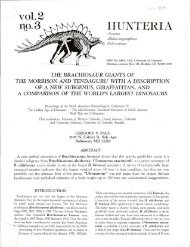THE MANY MYTHS, SOME OLD, SOME NEW, OF ... - Gregory S. Paul
THE MANY MYTHS, SOME OLD, SOME NEW, OF ... - Gregory S. Paul
THE MANY MYTHS, SOME OLD, SOME NEW, OF ... - Gregory S. Paul
Create successful ePaper yourself
Turn your PDF publications into a flip-book with our unique Google optimized e-Paper software.
86 G. S. PAUL<br />
HERBIVOROUS DINOSAURS JUST ATE PLANTS<br />
Myth: It is generally thought that prosauropods, sauropods, and ornithischians<br />
limited their diets to assorted plant matter.<br />
Reality: Some ornithischians, such as adult broad beaked ankylosaurs, iguanodonts<br />
and hadrosaurs, probably were full time herbivores. However, the sharp beaks,<br />
premaxillary teeth, and speed of small adult ornithopods were well suited for hunting<br />
nonflying insects and small animals, and scavenging carcasses. The small heads and<br />
slender necks of pro sauropods and sauropods suggest that they may have picked up<br />
small animals on occasion, and even scavenged carcasses. The parrot beaks and<br />
shearing teeth, powered by massive jaw muscles, of protoceratopsids and ceratopsids<br />
suggest that they were omnivores, rather like suids and entelodonts. They<br />
may have competed with theropods to feed on carcasses. In all the adult examples,<br />
animal tissue probably only made up about a tenth or less of the total diet, so the<br />
effect on energy-flow dynamics in dinosaur communities was probably modest at<br />
best.<br />
BIG <strong>THE</strong>ROPODS DID NOT HUNT FOR A LIVING<br />
Myth: The big theropods, tyrannosaurs especially, were too big and slow to hunt<br />
prey, so they only scavenged (as per Halstead and Halstead, 1981; Barsbold, 1983).<br />
Reality: I have discredited this myth in detail elsewhere (<strong>Paul</strong>, 1988a). Suffice it to<br />
say that it is hardly likely that a 6 tonne animal with a 1.3 m long head, filled with<br />
massive jaw closing muscles that powered rows of teeth up to 150 mm long, and able<br />
to run like a great bird, would go hungry waiting for herbivores to drop dead for it.<br />
The problem of hunting safety for giant predators was solved by the use of<br />
hit-and-run tactics in which they quickly delivered crippling wounds, and then left<br />
the prey until it was too weak to be a threat. Confirming that big theropods were an<br />
active threat to big herbivorous dinosaurs is the array of armor, weaponry, and speed<br />
that the latter often employed to protect themselves (see below).<br />
DEFENSIVE NEEDS WERE NOT A DRIVING FORCE<br />
BEHIND <strong>THE</strong> EVOLUTION <strong>OF</strong> DINOSAURIAN<br />
WEAPONRY AND ARMOR, AND INTRASPECIFIC<br />
COMBAT WAS RELATIVELY SAFE<br />
Myth: In modern ungulates, horns evolved primarily for intraspecific purposes<br />
(Janis, 1982). Defense is at most a secondary consideration, and thermoregulation is<br />
another important function. Intraspecific weapons are designed to minimize damage<br />
on both sides. The horns of ceratopsids likewise developed for safe intraspecific<br />
combat, and they and armored dinosaur tail clubs and spikes developed as heat<br />
radiators (Farlow and Dodson, 1975; Horner and Gorman, 1988; Rigby, 1989).<br />
Reality: As usual, the real situation is much more complex. Field observation and<br />
paleobiological research have demonstrated that anti-predator defense is a primary<br />
function of the weaponry of many modern and recent ungulates (Kruuk, 1972;<br />
Schaller, 1972; Sinclair, 1977; Kingdon, 1982; Guthrie, 1990). There are grades of<br />
defensive versus intraspecific function of weaponry, with rhinos, Cape buffalo,<br />
eland, bison, sable and so forth aggressively defending themselves with their horns









